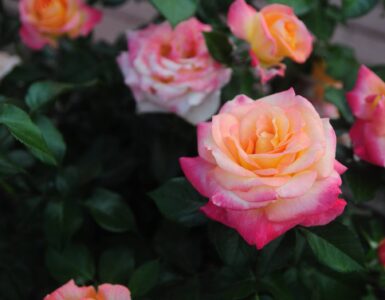Darin Engh, from Engh Gardens, plays the Plant Whisperer and tells us what plants are trying to say.
Making the Most of Water
Finger Test
THE NUMBER ONE cause of plant fatalities is watering. To determine if your plants need water, poke your finger about 1 inch into the soil. If it’s dry, water it slowly, and allow the moisture to percolate deeply into the soil. All plants have different requirements, so no preset schedule, no matter how well it works for you, will satisfy their needs.
Are you overwatering? Some plants prefer marshlike conditions, while other will not. Wet conditions can encourage disease and rot.
Are you underwatering? Natives and drought tolerant plants prefer a little drought now and again, but even they require enough water to access nutrients from the soil. Water deeply but less frequently rather than small amounts regularly.
The drying effects of hot, windy weather increase a plant’s need for moisture.
Watering is the most efficient when done in the morning. Water thoroughly and repeat the finger test to ensure that absorption has been sufficiently deep.
Take care not to flood the soil: flooding encourages fungi, soil compaction, and suffocation of plant roots. Sprinklers can encourage fungus diseases and rot. Soaker hoses are part of an effective watering system for beds and borders. Soaker hoses offer advantages over sprinklers: between 50 and 70 percent less water usage (no evaporation to the air), no water damage to blooms and foliage, and less water runoff and erosion.
Mulch plants with a good layer, which not only conserves water but suppresses weeds.
WHAT AILS THEM: COMMON PLANT DISEASES
Blossom-End Rot
Blossom-end rot frequently occurs in tomatoes and shows a dark, watery spot on the blossom end (usually the bottom of the fruit).
CAUSE: it’s the result of a calcium deficiency, but often the problem isn’t a lack of calcium in the soil, but a lack of water to transport calcium through the plant efficiently.
SOLUTION: To avoid, keep the soil evenly moist, but not soggy. Avoid sporadic watering. Even container can use a little mulch! Add crushed eggshell to the soil.
Powdery Mildew
Powdery mildew is a fungal disease that looks like a filmy alyer of white powder that has been sprinkled on the leaves of an infected plant. As the disease spreads, leaves deteriorate and die.
CAUSE: This disease is encouraged by high humidity and poor air circulation.
SOLUTION: The best plant is to know which plants are susceptible and to prepare you defenses as the summer heats up. Powdery mildew commonly affects catnip, zinnia, bee balm, sage, and roses. Prune excess foliage to open up air circulation.
Root-bound? Is the container too small for your plant? Are lots of roots pushing through the bottom drainage hole? This can lead to a lack of air around the roots, a lack of nutrition, and can starve the plant of water. It’s time to repot.
Yellow Means Caution
YELLOW LEAVES and bright green veins, often signs of iron-hungry plants, may also be a warning that you’re overwatering. Soggy soils slow or stop the release of iron to the plants. Remember to water only when the soil is dry, and use a fork to gently (without harming roots) aerate the soil.
No Wet Feet
To keep your plants healthy and free of fungus and mildew, set them on a tray of glazed saucer filled with about 1 inch of gravel. Water early in the morning to carry plants through the heat of the day, and drain any excess water from the tray. Never let your pots sit directly in standing water!
SICK PLANTS showing signs of distress should be isolated from your healthy population. First, move them to a well-lit recovery area with good air circulation. Then treat the soil and plants. Blast off! A powerful spray of water can destroy up to 90 percent of aphid and mite problems. For scale infestations, spot-treat with rubbing alcohol.
Become a Plant Whisperer
If you look closely, your plants will tell you where the soil is lacking nutritionally. Get familiar with the look of your plants when they are healthy, so you’ll know when something just isn’t right.
• Phosphorus – Phosphorus is a general health food for plants. It’s essential fo flowering, developing healthy fruit, and resisting disease. Plants need phosphorus to develop healthy, strong root systems. Phosphorus-deficient plants have what seem like healthy, dark green leaves except they are often small and slow growing. Bonemeal is a good slow-but-steady fertilizer.
• Nitrogen – Nitrogen effects leaf growth. Nitrogen-rich soil produces lush, healthy foliage. Plants that lack nitrogen have stunted, yellow, and/or pale leaves while the stems are thin and weak. Bloodmeal, Fish Emulsion, Coffee Grounds, and Manure are high in nitrogen and can be added to your garden.
• Potassium – Potassium is the plant stress reliever, helping cranky plants cope with brief periods of cold, heat, and drought. It is responsible for producing sturdy stems and regulating the flow of nutrients through the plant system. When your plants need potassium they produce healthy-looking new leaves, but older foliage will often twist and cut, turning from yellow to brown along the edges before dropping off completely. Plants produce few flowers, all of which are sickly and of poor quality.
• Calcium – a sure sign of calcium deficiency is the presence of a tomato disease called blossom end rot. Plants produce fruit with a yucky brown, wet-looking spot on the underside.
• Magnesium – when magnesium is missing older leaves turn yellow while the veins stay green.
• Iron – young foliage appears white or light yellow between the veins while the older leaves remain green when the plant isn’t getting enough iron.
-Fertilize during the growing season only. Give your plants a break during the winter or whenever they’ve gone dormant.
Insecticidal Soap
Works best on soft-bodied insects like aphids, whiteflies, thrips, and mealybug but must be applied directly to the insect’s body to work.
Slugs & Snails
Plants that repel snails include azaleas, apricot, basil, beans, California poppies, corn, chard, daffodils, fennel, fuchsias, grapes, ginger, holly, parsley, pumpkins, plum, rhododendrons, rhubarb, sage, and Swedish ivy.
Slug Stoppers
Snails and slugs dislike slithering over sharp, gritty materials. Barriers should be several inches deep and encircle the plant entirely. Effective barriers include: ashes (hardwood), bark, charcoal, copper, eggshells, gravel, hair, lime, sand, sandpaper, sawdust, wood or bark chips.
Bury bowls of beer in the soil. The enticing odor of beer will attract the pests so that they slither into the bowl, get drunk, and drown.
Prevention
• Keep the garden clean, of plant debris and weeds that can become a residence for insects.
• Practice companion planting
o Garlic and nasturtiums repel aphids especially on roses, potatoes, and tomatoes.
o Lupins help the soil by concentrating lime and increasing nitrogen.
o Mint repels ants.
o Marigold help deter harmful insects in vegetable gardens.
• Grow varieties that are resistant to insects or diseases.
• Rotate crops to inhibit the population of insects and soil-borne diseases.
CROP ROTATION
Crop rotation balances the give-and-take of plants and the soil. Rotating crops accomplishes three important things:
1. It discourages soil-borne disease organisms and insects that attack specific plants.
2. It prevents the localized depletion of specific soil minerals and nutrients by one plant. Alternatively, it can create soils that have been nutritionally improved by a previous crop.
3. It creates deeper, aerated soils by root penetration.
The addition of compost and other organic matter helps to restore nutrients depleted by previous crops.
Your first reaction to moldy-looking leaves or a newly dying plant might be to grab a bottle and start spraying.
But before you get nuts with the sprays, remember that the presence of disease is often the sigh of a cultural problem in the garden. Usually disease shows that the plant itself isn’t getting what it needs (light, water, nutrition, air circulation) or it’s getting too much! Look claser at the conditions you plant is growing in to figure out what isn’t quite right. Practice a good defense in your garden.
• Keep It Tidy – don’t let diseased leaves sit around in the soil.
• Prune, Prune, Prune – most mildew and fungal diseases thrive in humid, warm environments. Pruning increases air circulation around the leaves, providing a breath of fresh air.
• Clean Your Tools – just like someone with a cold who spreads germs by reaching into a bowl of bar peanuts, dirty tools spread diseases from one plant to another.
• Water the Soil, Not the Leaves – disease strikes when plants have too much humidity around the leaves. If leaves do get watered (by sprinklers), water early in the day so they can dry out before nightfall.
Build Healthy Soil – healthy soil equals healthy plants equals stronger disease resistance
Cat Garden
Nothing is more serene that working the garden on a summer day with your best feline friend lazing in the sun beside you. Until Fluffy gets a hankering to munch on some fresh greens! Of course, she’ll pass up all the cheap annuals and head straight for an expensive new purchase or your fanciest flower.
One way to keep kitty off the goods is to drum up some dazzle camouflage and distract her with greener, tastier pastures. There’s a wide, wide world of plants out there that cats can’t resist. Create a mixed container with some of the cat-enticing plants and set it away from other plants. With her own private spot filled with irresistible treats, your cat won’t be tempted by your prized veggies and ornamentals.
Kitty Herbs
-catnip
-persian catmint
-valerian
-grasses
Or if the neighbors friendly feline strays into your yard try these Cat Repellents:
-sprinkle citrus peels and cayenne pepper on the soil
-spray vinegar on soil (make sure to keep off plants)
-apply Vicks VapoRub to the edges of pots or garden borders
For more information, you can contact Darin at Engh Gardens in Sandy or online at www.enghgardens.com















Add comment